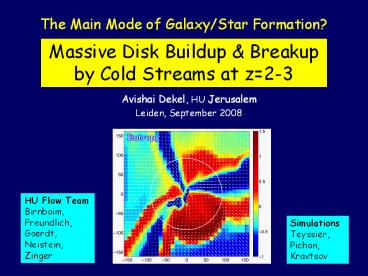The Main Mode of Galaxy/Star Formation? - PowerPoint PPT Presentation
1 / 37
Title:
The Main Mode of Galaxy/Star Formation?
Description:
the millenium cosmological simulation. high-sigma halos: fed by ... May explain high-SFR galaxies if - a similar flux penetrates to the disk - it is ... – PowerPoint PPT presentation
Number of Views:60
Avg rating:3.0/5.0
Title: The Main Mode of Galaxy/Star Formation?
1
The Main Mode of Galaxy/Star Formation?
Massive Disk Buildup Breakup by Cold Streams at
z2-3
Avishai Dekel, HU Jerusalem Leiden, September 2008
HU Flow Team Birnboim, Freundlich, Goerdt,
Neistein, Zinger
Simulations Teyssier, Pichon, Kravtsov
2
Outline
- Massive galaxies at high z
narrow cold streams through hot halos - Inflow rate into the halo and into the disk
- Smooth flows vs Mergers
- High-SFR galaxies at z2-3
- Disk breakup and bulge formation
3
Shock-Heating Scale
Birnboim Dekel 03 Dekel Birnboim 06
Keres et al 05
stable shock
Mvir M?
6x1011 M?
typical halos
unstable shock
4
(No Transcript)
5
The Critical Mass Cosmological Simulations
SPH Keres et al 2005, AMR Kravtsov et al
Mgt1012M? virial shock heating
Mltlt1012M? cold flows
virial radius
6
Fraction of Cold Gas in Halos Cosmological
simulations (Kravtsov)?
cold
hot
Birnboim, Dekel, Neistein 2007
Zinger, Birnboim, Dekel, Kravtsov
7
A virial shock in a 3D cosmological simulation
at Mcrit rapid expansion from the inner halo to
Rvir
d(Entropy)/dt
Libeskind, Birnboim, Dekel 08
8
Cold Streams in Hot Massive Halos at High z
Dekel Birnboim 2006 Dekel et al. 2008
9
(No Transcript)
10
(No Transcript)
11
(No Transcript)
12
high-sigma halos fed by relatively thin, dense
filaments ? cold narrow streams
typical halos reside in relatively thick
filaments, fed spherically ? no cold streams
the millenium cosmological simulation
13
Origin of dense filaments in hot halos
(MMshock)at high z
At low z, Mshock halos are typical they reside
in thicker filaments of comparable density
MsM
At high z, Mshock halos are high-s peaks they
are fed by a few thinner filaments of higher
density
MsgtgtM
Large-scale filaments grow self-similarly with
M(t) and always have typical width R ?M1/3
14
(No Transcript)
15
(No Transcript)
16
Gas Density in Massive Halos 2x1012M?
high z
low z
M1012M?
M1012M?
Ocvirk, Pichon, Teyssier 08
17
(No Transcript)
18
Observed Maximum Bursts
Genzel et al. 2006,
- Optical/UV-selected galaxies at z2-2.5 -
Mstar1011M? SFR 200 M? yr-1 - Most
of the mass is bursting -gt gaseous input - Very
rapid SFR burst 0.5 Gyr
...tSFR lt Rvir/Vvir tcool ltlt tHubble
- Disk morphology kinematics no major mergers
19
Massive high-z disks by cold narrow streams
Dekel et al. 2008, Nature MareNostrum AMR
simulation 50 Mpc cosmological box 1
kpc resolution Ocvirk,
Pichon, Teyssier 2008
Mvir1012M? at z2.5
20
Gas density following dark-matter filaments
21
Entropy virial shock low-entropy streams
22
Inward gas flux all in the streams
.
23
Another example
Always 3 streams?
24
Flux per solid angle
25
Flux per solid angle
26
Average Assembly Rate into Rvir by EPS
Neistein, van den Bosch, Dekel 06 Birnboim,
Dekel, Neistein 07 Neistein Dekel 07, 08
Growth rate of main progenitor (time invariant)
Approximate for LCDM
M2x1012M? z2.2 ? dM/dt 200 M?yr-1
May explain high-SFR galaxies if
- a similar flux penetrates to the disk - it is
gas rich -
SFR follows rapidly
27
Inflow Rate into the Disk
At z2-3, M1012M?, the input rate into the disk
is comparable to the infall rate into the virial
shock, most of it along narrow streams
28
Conditional Distribution of Gas Inflow Rate
mergers gt110
smooth flows
29
(No Transcript)
30
Contribution of Different Masses
lt12.5
31
At Different Redshifts
similar n(gtSFR) at z2-3
3
4
32
Streams in 3D partly clumpy
33
Half the stream mass is in clump gt110
Birnboim, Zinger, Dekel, Kravtsov
34
Inflow Rate into the Disk
50 of the flux is in mergers gt 110 but the
duty cycle is lt 10
35
Fraction of Mergers
At a given Mdot, 75 of the galaxies are fed by
smooth flows
BzK/BX/BM are mostly mini-minor mergers lt110,
i.e. smooth flows
Bright SMG are half-and-half mergers gt110 and
smooth flows
SFG Stream-Fed Galaxies
36
(No Transcript)
37
Streams Clumpy Disk - Bulge
One stream with impact parameter Rdisk
determines the disk spin, while other streams
generate turbulence
The streams provide continuous rapid gas supply
into a disk ? Jeans instability
At zgt2, the streams maintain high dispersion
? Giant clumps. They interact, lose AM, and
coalesce into a compact spheroid - classical
bulge (Noguchi 99 Elmegreen,
Bournaud, Elmegreen 08)
38
(No Transcript)
39
(No Transcript)
40
Column density of cold, in-streaming gas
Detectable by absorption External source
c.d.gt20 cm-2 at 30 sky coverage Internal
source c.d.gt21 cm-2 at 5 sky coverage
41
Here is what it should look like in Ha
42
(No Transcript)
43
Conclusions SFG Stream-Fed Galaxies
At z2-3, disks of 1011M? grow rapidly via
narrow cold gas streams
through shock-heated halos
Penetration disk input rate halo entry rate
200 M? yr-1
Abundance SFRgt150 at n3x10-4 , SFRgt500 at
n6x10-5
Observed SFGs ? SFR must closely follow gas
input rate
At zgt2, streams generate rotation maintain
gas-rich turbulent disk ? giant clumps ?
(1) SFR (2) coalescence into a spheroid
Streams are half clumps gt110 and half smooth,
merger duty cycle lt0.1
Most sBzK/BX/BM are fed by smooth streams in
halos 1012-13M?
Half the SMG are mergers gt110
The cold streams should be detectable at zgt2 in
absorption and emission (DLAS? Lyman-limit?
Lyman-alpha emitters?)?































